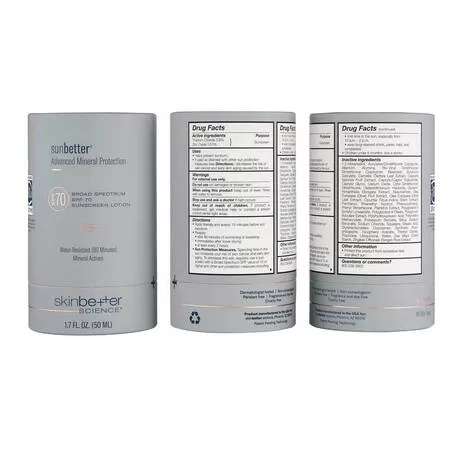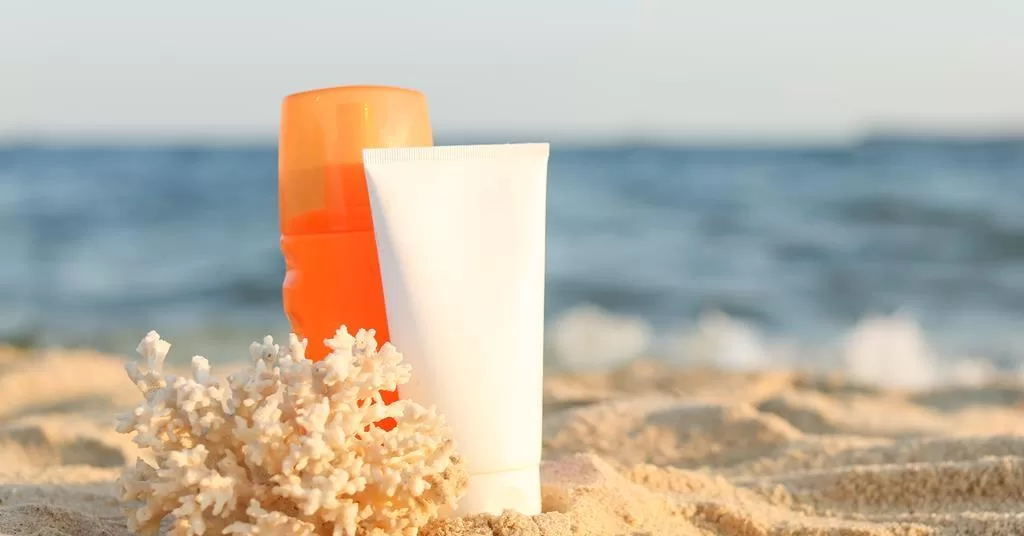As the sun’s rays grow stronger and the weather warms up, it’s essential to protect our skin from harmful UV radiation. However, with the plethora of sunscreen options available, choosing the right one can be overwhelming. In this guide, we’ll explore the key differences between mineral and chemical sunscreens, helping you make an informed decision about which type is best for your skin and the environment.
Difference Between Mineral and Chemical Sunscreen
Mineral and chemical sunscreens operate on distinct mechanisms to safeguard the skin against UV radiation. Imagine the protective barrier of mineral sunscreen as akin to wearing a sun shirt for your skin. Mineral sunscreens, also referred to as physical sunscreens, incorporate active ingredients such as zinc oxide or titanium dioxide. These ingredients form a shield on the skin’s surface, reflecting and scattering UV rays away from the skin. Conversely, chemical sunscreens contain organic compounds that absorb UV radiation, transforming it into heat, which is subsequently released from the skin.
Identifying Mineral Sunscreens
When perusing the sunscreen aisle, deciphering whether a product is mineral-based can be as simple as flipping the bottle and scanning the list of active ingredients. Mineral sunscreens rely on specific minerals to provide protection against UV radiation. Here’s how to tell if your sunscreen falls into this category:
Check the Active Ingredients:
- Zinc Oxide: Look for zinc oxide listed as one of the active ingredients. This natural mineral acts as a physical barrier, reflecting and scattering UV rays away from the skin’s surface. Zinc oxide is highly effective against both UVA and UVB rays and is well-tolerated by most skin types, including sensitive skin.
- Titanium Dioxide: In addition to zinc oxide, some mineral sunscreens may contain titanium dioxide as a primary active ingredient. Like zinc oxide, titanium dioxide forms a protective barrier on the skin, deflecting UV rays and reducing the risk of sun damage. Titanium dioxide is also prized for its gentle, non-irritating properties, making it suitable for sensitive skin.

Look for Broad-Spectrum Protection:
Ensure that the mineral sunscreen offers broad-spectrum protection against both UVA and UVB rays. This comprehensive coverage is essential for shielding the skin from sunburn, premature aging, and skin cancer. Many mineral sunscreens proudly display “broad-spectrum” on the label to emphasize their full-spectrum protection.
Verify SPF Rating:
Check the Sun Protection Factor (SPF) rating on the sunscreen label to determine its level of protection against UVB rays. Mineral sunscreens are available in a range of SPF values, from SPF 30 to SPF 50+, allowing users to choose the level of sun protection that best suits their needs. Opt for a higher SPF for extended outdoor activities or prolonged sun exposure.
Consider Additional Ingredients:
While zinc oxide and titanium dioxide are the primary active ingredients in mineral sunscreens, take note of any other components listed in the formula. Look for nourishing additives like antioxidants, vitamins, and botanical extracts, which can provide added skin benefits and enhance the overall efficacy of the sunscreen.
The Pros and Cons of Mineral vs. Chemical Sunscreen
When it comes to protecting our skin from the sun’s harmful UV rays, choosing the right sunscreen is crucial for maintaining skin health and preventing sun damage.
Skin Safety Showdown
While both types of sunscreen can effectively prevent sunburn and reduce the risk of skin cancer, there are important considerations regarding their safety and potential health impacts. Chemical sunscreens have come under scrutiny for their ability to penetrate the skin and potentially disrupt hormonal balance. In contrast, mineral sunscreens are considered safer and less likely to cause irritation or allergic reactions, making them a preferred choice for individuals with sensitive skin or underlying health conditions.

Let’s delve deeper into the pros and cons of mineral and chemical sunscreens, shedding light on their respective benefits and potential risks:
Mineral Sunscreens:
Pros:
- Gentle Formulation: Mineral sunscreens typically contain natural minerals like zinc oxide and titanium dioxide, making them suitable for sensitive skin types. These inert minerals sit on the skin’s surface, creating a physical barrier that reflects and scatters UV rays away from the skin.
- Broad-Spectrum Protection: Mineral sunscreens offer broad-spectrum protection against both UVA and UVB rays, providing comprehensive defense against sunburn, premature aging, and skin cancer.
- Immediate Efficacy: Unlike chemical sunscreens, which require time to absorb into the skin before becoming effective, mineral sunscreens provide instant protection upon application, making them ideal for on-the-go use.
Cons:
- White Cast: One common drawback of mineral sunscreens is the potential for a white cast or visible residue on the skin, especially with higher concentrations of zinc oxide. However, newer formulations have improved texture and reduced white cast.
- Thicker Texture: Mineral sunscreens tend to have a thicker, more viscous consistency compared to chemical sunscreens, which may feel heavy or greasy on the skin, particularly in warmer climates.
Chemical Sunscreens:
Pros:
- Lightweight Texture: Chemical sunscreens are often praised for their lightweight, fluid consistency, which absorbs quickly into the skin without leaving a greasy or heavy residue. This makes them more appealing for daily use under makeup or during physical activities.
- Cosmetically Elegant: Chemical sunscreens are available in a wide range of formulations, including lotions, creams, gels, and sprays, offering greater versatility and convenience for users with different preferences and skin types.
- High SPF Options: Many chemical sunscreens boast high Sun Protection Factor (SPF) ratings, providing superior protection against UV radiation in a single application. This can be advantageous for individuals with fair or sensitive skin who require maximum sun protection.
Cons:
- Skin Absorption: The active ingredients in chemical sunscreens, such as avobenzone, octocrylene, and homosalate, are designed to be absorbed into the skin, where they absorb and dissipate UV radiation. However, this process may raise concerns about potential systemic absorption and long-term health effects, especially with frequent or prolonged use.
- Skin Sensitivity: Some individuals may experience skin irritation or allergic reactions to certain chemical sunscreen ingredients, such as oxybenzone or octinoxate. This can manifest as redness, itching, or a burning sensation, particularly in individuals with sensitive or reactive skin.
- Environmental Impact: Chemical sunscreens have come under scrutiny for their potential environmental impact, particularly on marine ecosystems and coral reefs. Certain chemical UV filters, such as oxybenzone and octinoxate, have been shown to contribute to coral bleaching and coral reef degradation, prompting bans and restrictions in sensitive marine environments.
The Environmental Impact of Sunscreen
In addition to safeguarding our skin, it’s crucial to consider the environmental impact of sunscreen use. By making informed choices and selecting sunscreen products that prioritize both skin health and environmental sustainability, individuals can play a role in preserving marine ecosystems and protecting the planet for future generations.

Protecting More Than Your Skin
Certain ingredients commonly found in chemical sunscreens have raised concerns about their effects on marine ecosystems, particularly coral reefs. Here’s a closer look at the environmental implications of sunscreen use and how you can make eco-conscious choices:
Coral Reef Bleaching
Chemical sunscreens containing oxybenzone and octinoxate have been linked to coral reef bleaching, a phenomenon where corals expel the algae living within their tissues, leading to their whitening and eventual death. These chemicals can disrupt coral’s reproduction and growth cycles, making them more vulnerable to environmental stressors such as rising sea temperatures and pollution.
Marine Toxicity
In addition to coral reefs, chemical sunscreen ingredients pose risks to marine life, including fish, algae, and other aquatic organisms. Studies have shown that oxybenzone and octinoxate can accumulate in the water, where they may be ingested by marine species or absorbed through their skin. This can disrupt hormonal balance, impair reproductive functions, and cause developmental abnormalities in marine organisms.
States with Laws Regarding Sunscreen
Several states in the United States have implemented laws and regulations regarding sunscreen to protect marine life and coral reefs. For instance, Hawaii was the first state to pass legislation banning the sale of sunscreens containing oxybenzone and octinoxate, two chemicals known to harm coral reefs. This law came into effect in January 2021, prohibiting the sale, distribution, and use of sunscreens containing these harmful ingredients without a prescription.
Similarly, Florida followed suit with its legislation banning the sale of sunscreens containing oxybenzone and octinoxate, which took effect in July 2021. The state of California has also proposed legislation to ban these chemicals in sunscreen products, highlighting the growing concern over their environmental impact.
Other states, such as Key West in Florida and the U.S. Virgin Islands, have enacted local ordinances to prohibit the use of certain chemical sunscreens containing oxybenzone and octinoxate to protect their marine ecosystems.
These legislative efforts aim to safeguard fragile marine environments by reducing the harmful effects of chemical sunscreen ingredients. By implementing these laws, states are taking proactive measures to promote the use of reef-safe and environmentally friendly sunscreen alternatives.
Choosing the Right Sunscreen
Selecting the right sunscreen involves considering factors such as SPF level, water resistance, and application preferences. Mineral sunscreens offer broad-spectrum protection and are suitable for sensitive skin types, while chemical sunscreens may be preferred for their lightweight, non-greasy formulations. Ultimately, the best sunscreen is one that you’ll apply generously and reapply regularly to ensure continuous protection against UV damage.
Finding Your Perfect Match
Choosing the right sunscreen can seem daunting with so many options available on the market. However, understanding your skin’s needs and preferences can simplify the selection process. Here’s a comprehensive guide to help you find your ideal sunscreen:
1. Determine Your Skin Type:
Consider your skin type and specific concerns when selecting a sunscreen. If you have sensitive skin or are prone to breakouts, opt for a sunscreen that is hypoallergenic and non-comedogenic to prevent irritation and acne flare-ups. Those with oily skin may prefer lightweight, oil-free formulas, while individuals with dry skin may benefit from moisturizing sunscreens with added hydrating ingredients like hyaluronic acid or glycerin.
2. Understand SPF and Broad-Spectrum Protection:
Check the Sun Protection Factor (SPF) of the sunscreen, which indicates its effectiveness in blocking UVB rays responsible for sunburns. Choose a broad-spectrum sunscreen that offers protection against both UVB and UVA rays, which can cause premature aging and skin cancer. Look for sunscreens with SPF 30 or higher for adequate protection against sun damage.
3. Mineral vs. Chemical Sunscreens:
Decide between mineral (physical) and chemical sunscreens based on your preferences and skin sensitivities. Mineral sunscreens contain active ingredients like zinc oxide and titanium dioxide, which sit on the skin’s surface and physically block UV rays. They are gentle on sensitive skin and offer immediate protection upon application. In contrast, chemical sunscreens contain organic compounds that absorb UV radiation and convert it into heat, which is then released from the skin. While chemical sunscreens may be cosmetically elegant and easier to apply, they can cause irritation in some individuals and may have environmental implications.
4. Check the Ingredients List:
Review the ingredients list to ensure that the sunscreen does not contain potentially harmful chemicals like oxybenzone, octinoxate, or avobenzone, which can be absorbed into the bloodstream and may pose health risks. Instead, look for mineral-based sunscreens with zinc oxide or titanium dioxide as active ingredients, as they are considered safer for both your skin and the environment.
5. Consider Additional Features:
Look for sunscreens with added benefits such as water resistance, antioxidant protection, and moisturizing properties. Water-resistant formulas are ideal for outdoor activities or swimming, while antioxidants like vitamin C and vitamin E can help neutralize free radicals and protect against oxidative stress. Hydrating sunscreens with nourishing ingredients like hyaluronic acid or ceramides can keep your skin moisturized and supple, especially during prolonged sun exposure.
6. Test Before Full Use:
Before applying sunscreen to your entire face or body, perform a patch test on a small area of skin to check for any adverse reactions or sensitivities. This can help you avoid potential irritation or allergic reactions and ensure that the sunscreen is compatible with your skin.
7. Reapply Regularly:
Remember to reapply sunscreen every two hours, or more frequently if swimming or sweating heavily. Applying an adequate amount of sunscreen and reapplying it regularly is essential to maintain optimal sun protection throughout the day.
By following these guidelines and considering your skin’s unique needs, you can find the perfect sunscreen that provides effective sun protection while keeping your skin healthy and radiant.
Conclusion
When it comes to choosing between mineral and chemical sunscreens, there is no one-size-fits-all solution. Each type has its own set of advantages and disadvantages, and the best choice ultimately depends on individual preferences, skin type, and lifestyle factors. By weighing the pros and cons of each option and prioritizing skin safety and environmental stewardship, consumers can make informed decisions to protect their skin and the planet.
